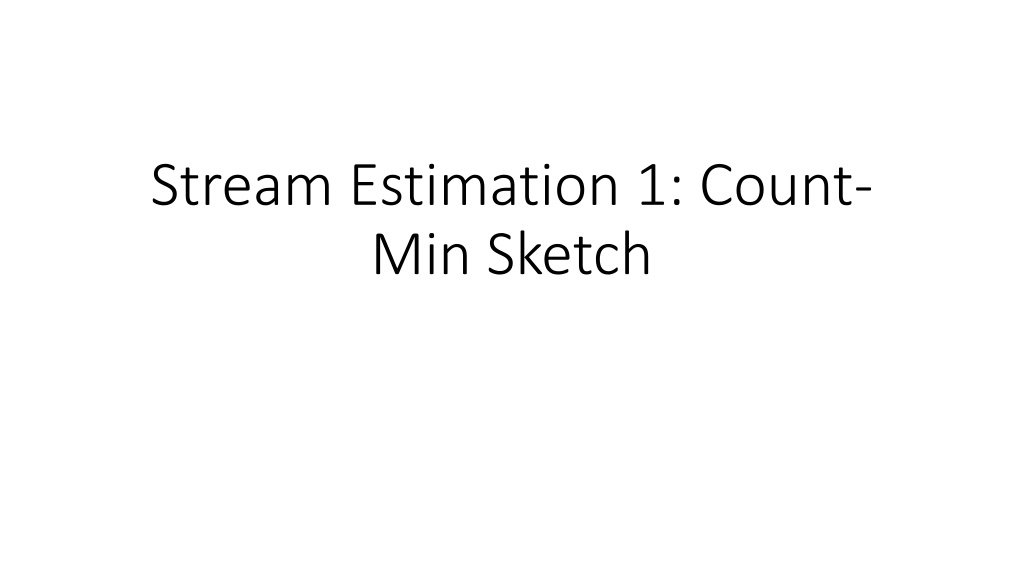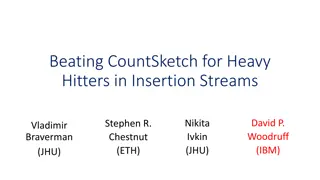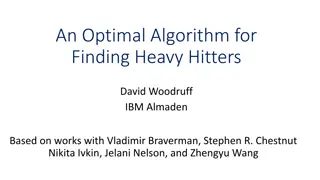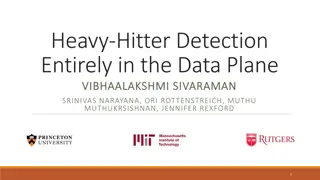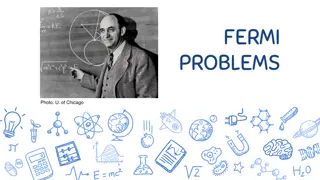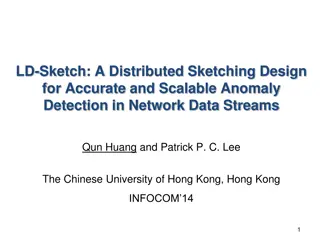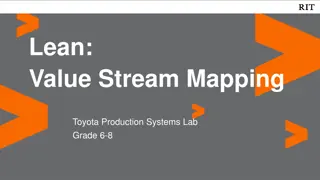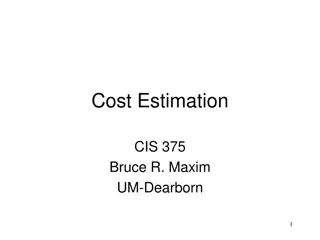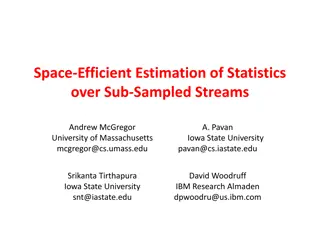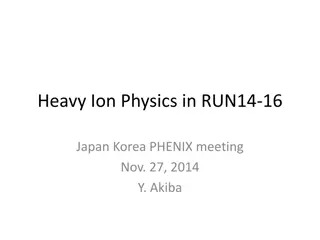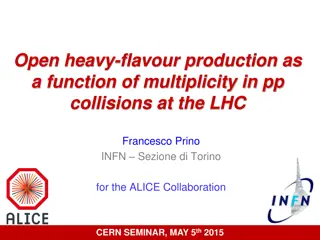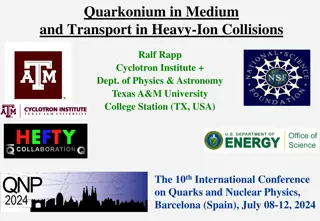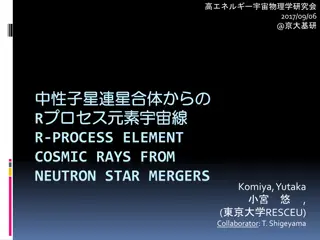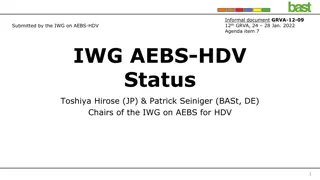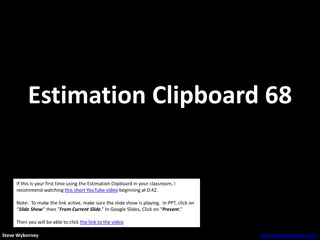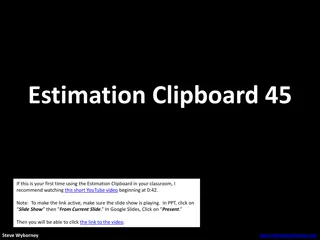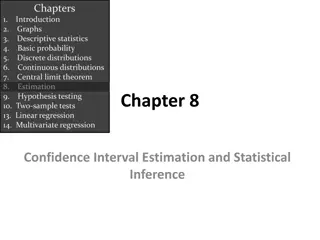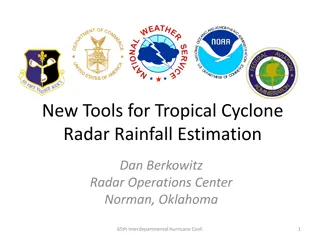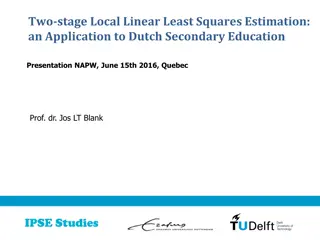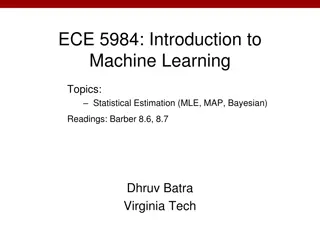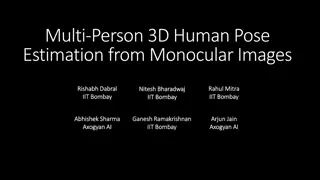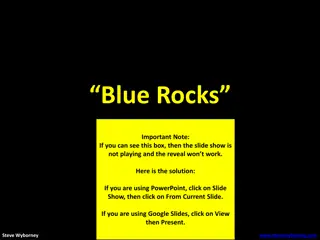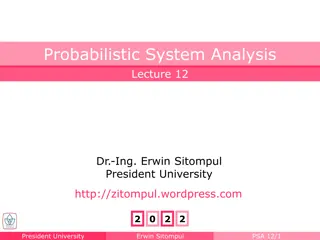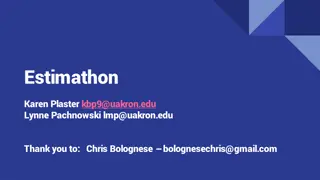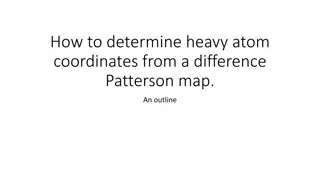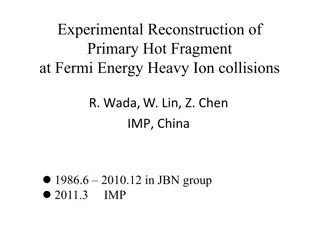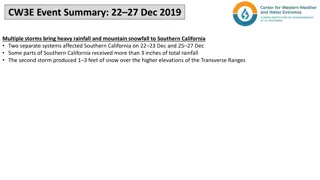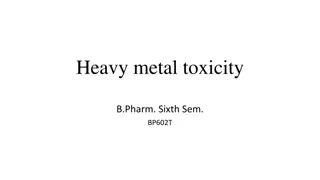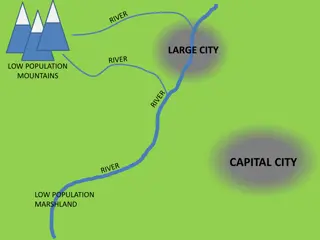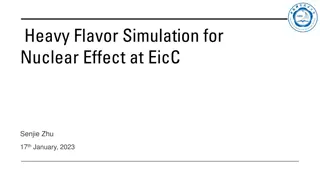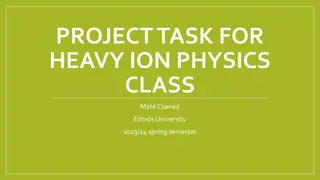Overview of Stream Estimation and Heavy Hitters Problems
Utilizing Count-Min Sketch methodology in scenarios where storing entire stream data is not feasible, such as mining query streams and sensor networks. Addressing the challenge of identifying heavy hitters in data sets like Twitter feeds and network traffic flows. Exploring the limitations of algorithms in solving heavy hitters problems efficiently.
Download Presentation

Please find below an Image/Link to download the presentation.
The content on the website is provided AS IS for your information and personal use only. It may not be sold, licensed, or shared on other websites without obtaining consent from the author. Download presentation by click this link. If you encounter any issues during the download, it is possible that the publisher has removed the file from their server.
E N D
Presentation Transcript
Stream Estimation 1: Count- Min Sketch
Contd.. Input data element enter one after another (i.e., in a stream). Cannot store the entire stream accessibly How do you make critical calculations about the stream using a limited amount of memory?
Applications Mining query streams Google wants to know what queries are more frequent today than yesterday Mining click streams Yahoo wants to know which of its pages are getting an unusual number of hits in the past hour Mining social network news feeds E.g., look for trending topics on Twitter, Facebook From http://www.mmds.org
Applications Sensor Networks Many sensors feeding into a central controller Telephone call records Data feeds into customer bills as well as settlements between telephone companies IP packets monitored at a switch Gather information for optimal routing Detect denial-of-service attacks From http://www.mmds.org
A Simple Problem (Heavy Hitters Problem) In a twitter feed, what are the top-50 phrases say upto four words in the last year? For every tweet, find all the contiguous 4-words (4-gram) and add them to dictionary. What is the size of dictionary Na ve Counting: Around a million possible words, so possible phrase is 106 4= 1024 But not all combinations are observed. There are around 500 million tweets per day and around 200 billion tweets per year. Even if every tweet has 2 new phrases of four words (very likely) then it is 400 billion strings! Even if we ignore strings (the hardest part), that is 1.6 terabytes of memory just to store the counts!!
More Heavy Hitter Problem Computing popular products and context: For example, we want to know popular page views of products on amazon.com given a variety of constraints. Identifying heavy TCP flows. A list of data packets passing through a network switch, each annotated with a source-destination pair of IP addresses and some context. The heavy hitters are then the flows that are sending the most traffic. This is useful for, among other things, identifying denial-of-service attacks Stock trends (co-occurrence in sets)
Can we do better? Not always. There is no algorithm that solves the Heavy Hitters problems (for all inputs) in one pass while using a sublinear amount of auxiliary space. Can be proven using pigeonhole principle.
Can we do better? Specific Inputs Finding the Majority Element: You re given as input an array A of length n, with the promise that it has a majority element a value that is repeated in strictly more than n/2 of the array s entries. Your task is to find the majority element. O(n) solution? Can you do it in one pass and O(1) storage?
The Solution For i = 0 to n-1{ if i == 0 { current = A[i]; currentcount = 1;} else { if (current == A[i]) currentcount++ else { currentcount - - if(currentcount == 0) current = A[i] } } } Proof?
Hope? General case. No! However, if we know that the stream contains element with large counts, then something is possible.
Power Law in Real World Exactly: No Hopes, we need dictionary O(N). Approximation : Wont be accurate on General Input Approximation and Power LawInput: YES!! Real word data follows power law. Some things are repeated all the time, most things occur rarely. Browsing History User Queries Phrases Human Patterns
Revise: Bloom Filters Use K-independent hash functions Just select seeds independently. K = 3 illustration ?2 ?1 0 0 1 0 1 0 1 0 0 1 0 1 1 1 0 Given a query q, if all 1? , 2? , 3? is set, return seen else no. False Positive Rate?
What can Bloom Filters with Counters do To simplify, lets just take 1 (K=1) random hash function and use counters instead of bits, so whenever s is occurred, increment h(s). h(s) 0 0 1 0 17 20 1 0 0 151 2 9 11 71 30 Given string q, estimate its frequency with the frequency of hashed counter h(q). Reminder with universal hash function, the probability of Pr(h(s) = c) = 1 ?
Survival of Fittest (natural selection) The Good + The Irrelevant + + The Unlucky
Points to Ponder No collision: we estimate exactly. Collisions always overestimate (if unlucky by a lot) Denote ??= ????? ?? ?????? ?. If s is frequent (heavy), then h(s) is a good estimate unless some other heavy r collides with h, i.e. h(s) = h(r), or too many tails present in h(s) Let = ??? ?? ??? ? ? ???????? = ? ?? Expected value of counter h(s) = ??+ Expected Error < R In power law, if s is head then ??= ? (some fraction of everything). 1 ? cs < cs+ R
Can we do better? Repeat Independently d times, take minimum (Count-Min) Unless all the d counters messes up simultaneously, we have a good estimate. For heavy hitters, unless every d counters has more than 2 heavy hitters we are fine.
Summary of Algorithm Take d, independent hash function 1,.. ? and d arrays of size R. Update: Any string s, increment ?? in array i. Estimate Counts: Given query q, return min ( 1? , 2? ,... ?(?)) Update and Estimate cost O(d)
Markov Inequality Pr ? > ? <? ? ? ; ? 0 For just 1 hash function, Denote 1 ?= ? Expected error (err) = ? (why? Previous slides) Pr ??? > 2? <1 2 So the error is worse than 2? , with d hash functions with probability 0.5? (d= 7 it is 0.007)
Mental Exercise When to increase d (number of hash functions)? When to increase R (or the range)?
Summary so far ! The estimate of ?? ????? ?? ?_? has guarantees ??< ?_? < ??+ ???with high probability If s is heavy hitters, generally ??= ? . Choose ? appropriately smaller than f and get relative error guarantee. High probability decays as 0.5? , so d generally around 4 to 5 is enough!
Memory requirements? 1 ?log1 ??< ? ? to ensure ?_? < ??+ ??? with probability 1 - ? for any given string s. How much to guarantee for all strings (N) in total? The union bound trick. Probability of failure for any given string s ? Probability that failure happens on any one of the N string ? ? So choose ? = ? Memory ? ?. N appears inside logarithm!! (exponentially less space). ? 1 ?log?
How to identify top-k? Given s, we can estimate its count quite accurately. How do we solve the identifying top-k problem? Use heaps Keep a minheap of size k Whenever, we see a string s, update, estimate and check if the estimate is less than min of top-k heap, update heap if more. (O(log(k))) total update cost dlogk in worst case.
Turnstile Model of Stream Assume an N dimensional vector V. We cannot afford O(N) space. At time t, we only get to see ?,?? which means that coordinate ? is changed by ?? 0 (no deletions). For counting problem, ? is the identity of string and ??= 1 We are only allowed log ? space. In the end, we want to get some estimate of any co-ordinate ?? and in particular identify elements with large values of ??
Can we use count-sketch in turnstile setting? At time t, we only get to see ?,?? which means that coordinate ? is changed by ??. We have identity of item ?, so hash it d times and add ?? to all hash counters. Hashing is a convenient way of handling turnstile setting.
Some Observation We saw that for the general problem, there is not much hope in < O(N) memory. However, with power law input, we can get exponential improvements! It is about solving problems and not getting stuck in formalism If you see an impossibility result, that only means that your formalism is not right (generally too harsh) for the problem at hand.
